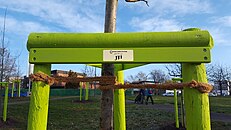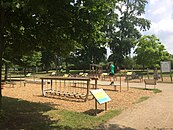Cologne Green Foundation
The Kölner Grün Foundation is a non-profit foundation under civil law based in Cologne . The purpose of the foundation is to maintain and maintain Cologne's historic green spaces for reasons of monument and nature conservation, as well as to raise funds for the realization of these purposes. The foundation is so far the only private foundation in Germany that has been working in close cooperation with the City of Cologne since 2006. Since the foundation was founded, several million euros have been invested in the renovation, maintenance and maintenance of Cologne's parks and street furniture .
founding
Committed to the work of their grandfather, the grandchildren of the former Lord Mayor of Cologne and later Chancellor Konrad Adenauer , Paul Bauwens-Adenauer and Patrick Adenauer , founded the Kölner Grün Foundation, which was presented to on November 17, 2006 for the first time with an inventory and a catalog of needs for action the Lord Mayor Fritz Schramma , went public. The foundation, under Beatrice Bülter as the managing director, pursues the goal of counteracting the sometimes desolate condition of Cologne's green spaces through further civic and urban commitment. Cologne personalities belong to the foundation's board of trustees. In January 2014, an advisory board with representatives from politics and administration was established.
Leitmotif
The foundation sees itself as a coordinator between sponsors from business, citizens and private initiatives. Thus, with the help of politics and administration, the foundation wants to recreate Cologne's large, well-tended "garden" from neglected individual areas.
History of Cologne
By the First World War, Cologne was expanded with a mighty inner and outer fortress belt: the 42 kilometer long fort belt comprised a total of 182 plants including fort systems, intermediate and supply works. Two broad fields of fire lay in front of the fortress belts. At the end of the First World War, the then Lord Mayor Konrad Adenauer (later first Federal Chancellor of the Federal Republic of Germany) succeeded in making the former military use of the facilities accessible to the civilian population: the forts were converted into "green forts" according to a general development plan by the Hamburg city builder Fritz Schumacher ( Sports fields, open-air schools, gardens). Former fields of fire have been integrated into the green system.
Actions
- 1000 benches for Cologne
- In the summer of 2007, the Cologne Green Foundation started the community foundation campaign “1000 benches for Cologne” to equip the inner and outer green belt as well as their radial connections and Cologne green spaces with more benches and waste bins. For a donation of 750 euros, citizens can donate a bank to one of the possible locations and have it marked with a brass plaque. Prominent donors were Birgit Schrowange, Wolfgang Niedecken from the BAP group, Christoph Maria Herbst, the Bläck Fööss and the festival committee of the Cologne Carnival. By 2019, almost 1,700 benches had been donated by private individuals.
- 1000 trees for Cologne
- Since 2013, citizens have been able to donate a street tree to this campaign. On average, a street tree together with the preparation of the planting site, the planting and two-year maintenance costs a total of 1,200 euros. If 600 euros are donated, the city of Cologne doubles the amount and the tree is planted. Citizens have the opportunity to immortalize themselves with text on the brass donor plaque.
- Multi-generation trim course
- The foundation already has five large fitness courses in Cologne on the left and right of the Rhine, z. B. at the Decksteiner Weiher, in the Beethovenpark, in Deutz and in the Merheimer Heide, renew and expand. Another project was the multi-generation trim course in the inner green belt, which was completed in 2015. There is the largest exercise course in Cologne and offers opportunities for young and old to meet: here you can not only do strength and endurance sports, but also use the equipment to mobilize and improve fine motor skills and coordination. Another large fitness course was created in Nippes, which also includes all kinds of equipment for exercising.
- Green belt impulse Cologne - basis for completing a vision
- The outer green belt is an essential element of the unique urban green system of the city of Cologne. Almost 100 years after the first expansion work began, there is a change from the forest and meadow belt that surrounds the city to an intensively used recreational area for the Cologne population that simultaneously fulfills valuable ecological and climatological functions. The past urban and traffic development, especially in the urban area on the right bank of the Rhine, has, however, led to the function of the green belt being impaired and in some cases no longer perceived as a coherent green space. Against this background, the foundation and the city of Cologne have agreed to have a development concept drawn up for the entire area of the outer green belt on the left and right of the Rhine. The landscape architecture office Werkgemeinschaft Freiraum from Nuremberg and the urban planning office Albert Speer & Partner from Frankfurt am Main were commissioned to work on the concept. The planning process, which lasted around a year, was accompanied by a public participation process divided into several steps and through the participation of the municipal and extra-urban departments, the political bodies and the specialist public. In 2012, the final resolution was passed in the council, and in May 2013 the then Lord Mayor of Cologne, Jürgen Roters, and the founders of the foundation, Paul Bauwens-Adenauer and Patrick Adenauer, signed the charter.
Prizes and awards
- The project "1000 Trees for Cologne" was recognized as an official project of the UN Decade of Biological Diversity in 2018.
- Hanns Schaefer Prize, 2008 - The prize was awarded for the foundation's exceptional commitment to the preservation and maintenance of the 2800 hectare outer green belt.
- Ears Order, 2010 - The Cologne Green Foundation was also awarded the "Ears Order" of the Cologne Civil Society in November 2010 for its commitment to upgrading the Cologne Green Belt. Paul Bauwens-Adenauer and his brother Patrick Adenauer accepted the award on behalf of the Grün Foundation. The bastion in the Volksgarten was then renovated from the 7,000 euros in prize money and donations.
- German Landscape Architecture Prize, 2013
- Acknowledgment for the Green Belt Impulse, 2012
literature
- Kölner Grün Foundation: Green Belt Impulse Cologne - Basis for completing a vision. Greven Verlag, Cologne 2013, ISBN 978-3-7743-0620-2 .
- Monica Freifrau Geyr von Schweppenburg: Living in the Green Area - The Cologne Green System. 2006.
- Daniela Mutschler: COLOGNE - how does it work? (= Bachems knowledge world ). JP Bachem Verlag, Cologne 2016, ISBN 978-3-7616-3001-3 .
Web links
Individual evidence
- ↑ Cologne fortresses . Retrieved December 4, 2013.
- ↑ Cologne Green Foundation . Retrieved December 4, 2013.
- ↑ 1,000 trees for Cologne , Cologne Green Foundation. Retrieved December 4, 2013.
- ↑ Multi-generation trim parcours Inner Green Belt ( Memento of the original from July 29, 2017 in the Internet Archive ) Info: The archive link has been inserted automatically and has not yet been checked. Please check the original and archive link according to the instructions and then remove this notice. , Cologne Green Foundation. Retrieved July 12, 2017.
- ^ Green belt impulse Cologne , Cologne Green Foundation. Retrieved December 4, 2013.
- ↑ German Landscape Architecture Prize 2013





